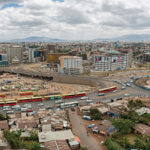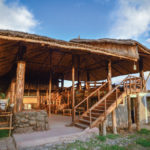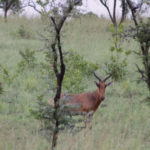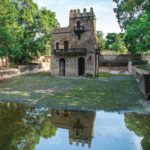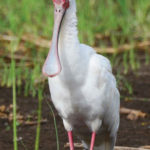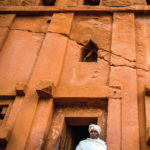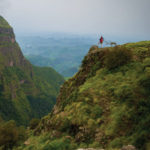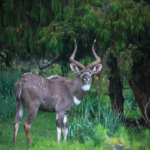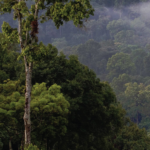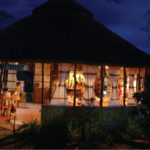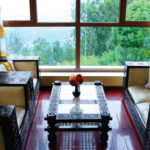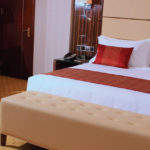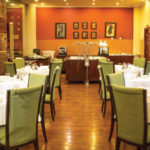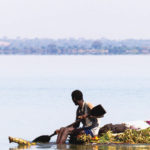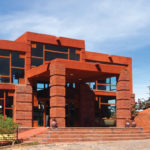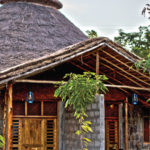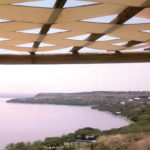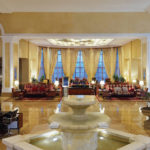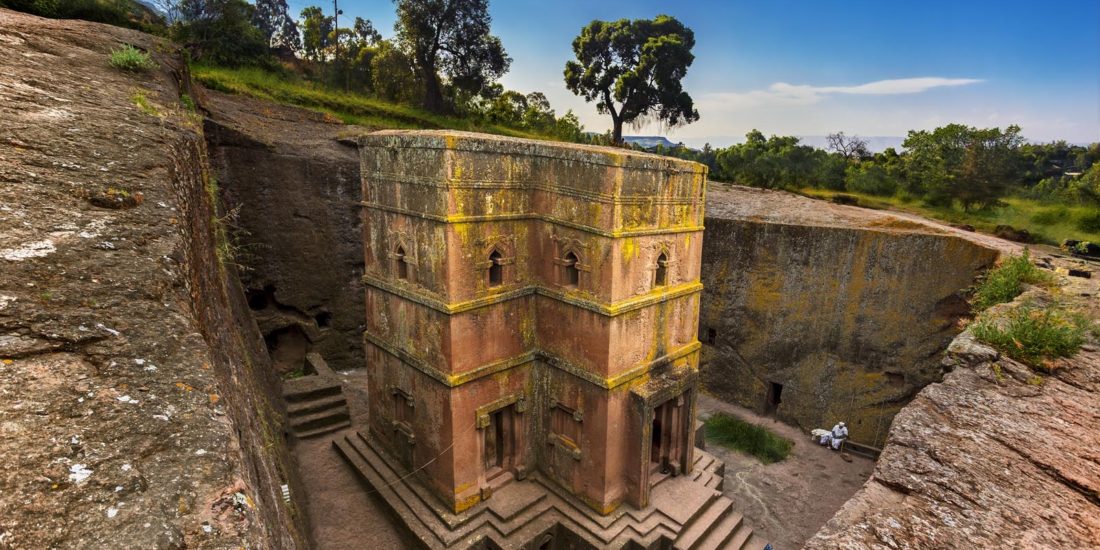ETHIOPIA
Ethiopia, in the Horn of Africa, is a rugged, landlocked country split by the Great Rift Valley. With archaeological finds dating back more than 3 million years, it’s a place of ancient culture. Among its important sites are Lalibela with its rock-cut Christian churches from the 12th–13th centuries. Aksum is the ruins of an ancient city with obelisks, tombs, castles and Our Lady Mary of Zion church.
Things to do
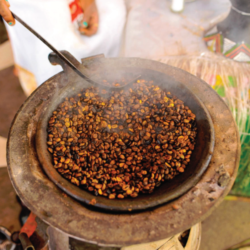
Coffee Forest Tours
The forests that swathe Ethiopia’s western highlands are the original home of coffee, which still grows profusely in the understory along with a wealth of other wildlife and sustainable forest products.
- The 7,600km2 Kafa Biosphere Reserve is the largest and most accessible of three such UNESCO-recognised reserves that protect Ethiopia’s western highlands. It is also an important repository of coffee genetic diversity, since many different varieties of bean still grow wild in the region.
. - The coffee-yielding montane rainforests of western Ethiopia also harbour numerous other sustainable forest products, including forest cardamom, forest pepper and honey.
. - Wildlife likely to be seen in the coffee forests of the west includes the black-and-white colobus monkey, along with a wonderful diversity of highland forest and grassland birds including 11 species endemic to Ethiopia.
. - Other important coffee-producing regions include Harar, Jimma, Yirga Chafe and the Lake Tana Basin. Wild or feral coffee plants are often to be seen in the understory of the small forest patches maintained by many rural churches and monasteries throughout Ethiopia.
. - The Bebeka and Tepi Coffee Estates, respectively the largest and second-largest in the country, are good places to learn about coffee production, and to ramble through dense montane forests alive with birdlife. Both also operate simple but comfortable guesthouses.

Cultural Tours
Ethiopia supports varied and complex cultural mosaic, with more than 80 languages and 200 dialects spoken in various parts of the country, and a similar ethnographic diversity.
- The Great Ethiopian Route: Historic North focuses on the predominantly Christian cultures of Amhara and Tigray. Highlights include the 3,000-year-old city of Aksum, which is still inhabited today, and the 17th century castles at Gondar. The Ethiopian Orthodox culture of the north is, however, epitomised by the age-old rock-hewn churches of Lalibela and Tigray, and the white-robed worshippers who gather there for services, as they have done since time immemorial.
. - The Cultural Mosaic of the South passes through areas dominated by Islam, Orthodox Christianity, various Protestant denominations, and traditional animists. It also incorporates what is perhaps Ethiopia’s most important location for ethnographic tourism in the form of the South Omo Valley, whose astonishing mix of small, contrasting and utterly fascinating ethnic groups includes the Hamer, Gangatom, Karo, Dassench, Bodi, Mursi, Surma and Arbore. Here, visitors have the opportunity to witness a variety of authentic African tradition, including colourful ornaments, elaborate hairstyles, colourful body painting, and unique traditional performing arts
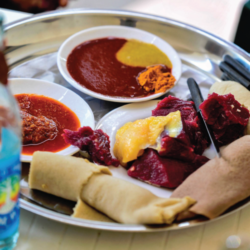
Eating and Drinking
Ethiopia has a unique cuisine, one that will appeal particularly to vegans and those with a taste for spice, but tourist-orientated hotels also serve a varied selection of international dishes catering to less adventurous palates.
The main Ethiopia staple is injera, a type of foam-textured pancake that comes in three different coloured varieties: white, brown and red. The dough for injera is fermented for three days before it is cooked, hence the texture and a slightly sour taste.
A variety of different stew-like sauces are eaten with injera. These include tibs (spicy fried meat mixed with onions and peppers), shiro (spicy puréed chickpeas) and kai wot (a hot stew usually made with fish, beef, goat or chicken meat).
Vegans are well catered for in Ethiopia, since the Orthodox Church recognises around 200 fasting days, when it is forbidden to eat any food containing animal products. Wednesday and Friday are always fasting days, as are the 40 days of Ethiopian Lent (most of March and April) and various other religious holidays. A common dish on fasting days is a kind of vegetable buffet called atkilt bayinetu, which comprises dollops of several vegan dishes placed on a plate of injera.
Popular drinks include locally brewed beer called tella and a kind of honey wine known as tej. Several varieties of chilled lager-type bottled beer are also available, while red and white Rift Valley Wine is produced by the French-owned Castel Winery in Ziway. Locally bottled Ambo sparkling mineral water is available almost everywhere, along with several brands of still water.
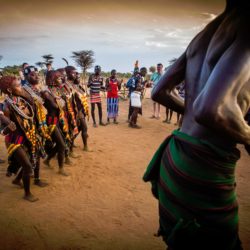
Festivals
Many tourists to Ethiopia try to time their visit to coincide with the colourful festivals of Meskel, Timkat or Enkutatash.
- Now registered with UNESCO as an element of the Intangible Cultural Heritage of Humanity, Meskel (27 September) commemorates the alleged 4th century discovery of the True Cross on which Jesus was crucified. The centrepiece of this uniquely Ethiopian festival is the burning of a massive conical pyre called a Damera. The largest ceremony takes place in Addis Ababa’s Meskel Square.
. - Timkat, the Ethiopian Orthodox equivalent to Epiphany, is celebrated at churches throughout the country on January 19. The best place to be during Timkat is Gondar, where the festivities culminate in a crowded and colourful afternoon re-enactment of the first baptism at the 17th century Fasil’s Pool, which is filled with water for the occasion.
. - Gena or Ledet (7 January), the Ethiopian equivalent to Christmas, is preceded by an all-night vigil following 43 days of fasting that culminate. It is a family-oriented holiday, but in some areas it is marked by traditional dancing or a hockey-like game called Yegenna Chewata, supposedly played by the local shepherds on the night Jesus was born. It is traditional to eat the national dish doro wot (chicken stew) over Gena.
. - Harar also comes alive during the Ashura ceremony, which takes place on the 10th day of Muharram, the first month of the Islamic calendar.
. - Important Islamic pilgrimage sites holding annual festivals include the Sof Omar Caves and Dire Sheikh Hussein in the lowlands east of the Bale Mountains.
. - A more secular occasion is Enkutatash, or Ethiopian New Year (11 September), which falls on the date that the Queen of Sheba supposedly arrived back in Aksum after having visited King Solomon in Jerusalem. It is celebrated vigorously throughout the country by people of all faiths.
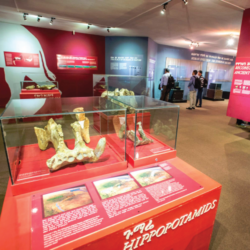
Museums
A network of museums in Addis Ababa and elsewhere explores Ethiopia’s long and fascinating history, from the first humans to walk the earth many million of years ago, to the imperial era that ran from around 1000 BC into the 1970s.
- The most popular display in Addis Ababa’s National Museum of Ethiopia is the superb palaeontological hall. This incorporates some of the world’s most ancient hominid fossils, including the 3.2-million-year-old Australopithecus afarensis skull known as Lucy, thereby substantiating Ethiopia’s probable status as the Cradle of Humankind.
. - The nearby Institute of Ethiopian Studies’ Ethnographic Museum focusses on the country’s varied mosaic of cultures. Highlights include extensive and attractively displayed collections of traditional musical instruments and of religious art dating back to the Middle Ages.
. - Centrally located on Meskel Square, the Red Terror Martyrs’ Memorial Museum documents the atrocities committed under the Derg regime of 1975-87.
. - Other subject-specific installations in the capital include the Addis Ababa Museum, National Postal Museum and Zoological Natural History Museum, and the museums associated with St George’s Cathedral, Selassie Cathedral and Entoto Maryam Church.
. - The Aksum Archaeological Museum, in the town of the same name, displays a wealth of ancient artefacts uncovered in the vicinity. Other worthwhile museums can be found in Harar, Lalibela and Konso.
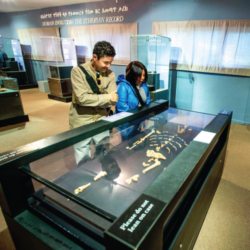
Paleontology
Ethiopia’s claim to be the Cradle of Humankind is the strongest of any country in the world, thanks to a remarkable series of paleontological discoveries, mostly in the Afar region of the northern Rift Valley. Indeed, of the 14 fossils and other relicts regarded to be most important in determining our understanding of human evolution, 11 were found in Ethiopia.
- The most famous fossil unearthed in Ethiopia is Lucy, the partial skeleton of a Australopithecus afarensis female discovered by the anthropologist Professor Donald Johanson and his student Tom Gray at Hadar in 1974. Then the oldest hominid fossil ever discovered at 3.2 million years old.
. - In 1997, the Ethiopian anthropologist Yohannes Haile-Selassie discovered the world’s oldest undisputed hominid remains, ascribed to the species Ardipithecus kadabba and dated to 5.5 million years old, in Afar.
. - Ethiopia has also yielded the world’s oldest-known stone-age tools. Dating back more than 2.5 million years, these were uncovered in Afar at a site called Gona.
. - A more southerly site alongside the Omo River has yielded the oldest-known fossils of anatomically modern humans Homo sapiens. Originally dated at 130,000 years old upon their discovery in the 1960s, this pair of skulls was re-dated at almost 200,000 years old in 2005.

Religious Travel
Ethiopia is one of the most devout countries in the world, boasting a unique Orthodox Christian denomination dating back to the 4th century AD, an Islamic tradition established during the lifetime of the Prophet Mohammed, and relicts of a Jewish culture that dates back to the reign of King Solomon.
- More than 300 rock-hewn churches are dotted around the country, some claimed to be more than 1,500 years old, and most still in use today. In terms of beauty and scope, none surpasses the 13th century complex of rock-hewn churches at Lalibela, which were originally conceived of as a kind of ‘New Jerusalem’ by King Lalibela, and remain active shrines to this day.
. - Negash, the earliest Islamic settlement in Africa, is the burial site of a group of followers of the Prophet Mohammed who fled from Mecca to Ethiopia in 613 AD to escape persecution. A mosque still stands on the site of the 7th century original.
. - The Biblical Ark of the Covenant, arguably the most holy of Old Testament artefacts, is believed to have first arrived in Ethiopia 3,000 years ago and is today preserved in a guarded temple in Aksum. The Ark is said to have been brought to Aksum by Emperor Menelik I, the son of King Solomon and the Queen of Sheba, and the founder of the Solomonic dynasty that reigned over Ethiopia until as recently as 1975.
. - This historic walled citadel of Harar, also known as the City of Saints, is the fourth-holiest city in the Islamic world, after Mecca, Medina and Jerusalem. An important repository of Islamic landmarks, it has a full 82 mosques and 438 Awaach (shrines of important Muslim scholars) crammed into 48 hectares – the largest such concentration in the world.
. - The abandoned synagogue at Woleka, near Gondar, evokes the story of the Beta Israel, a ‘lost tribe’ of Ethiopian Jews whose last 10,000-or-so adherents were airlifted to Israel during the 1980s.
. - Set in the lowlands east of the Bale Mountains, the Dire Sheik Hussein Shrine and Sof Omar Cave are important pilgrimage sites that attract hundreds of thousands of domestic and international Muslim pilgrims annually.
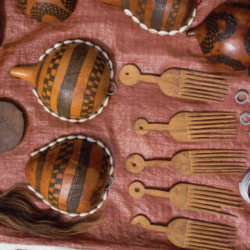
Shopping
A lively culture of traditional hand-worked craftsmanship and a plethora of markets all over the country make Ethiopia a wonderful destination for connoisseurs of high-quality traditional hand-woven cloths and other handicrafts.
Ethiopia is renowned for its traditional crosses, which are usually made from wood, silver or other metals. Small crosses are worn as necklaces by individual Orthodox Christians, while larger ones are used for ceremonial purposes. Hundreds of designs are available, with different styles being associated with the main northern centres of Aksum, Lalibela or Gondar.
For generations, Ethiopians have woven a wide variety of baskets and other containers for domestic use. Harar is said to be the home of the best basket makers, and their naturally-coloured products, often very old, take pride of place on the walls of the old town’s Arabic-style houses.
Dry gourds or calabashes, ornamented with leather straps for easier carrying, are used as containers for liquids and dry goods by the people of the south and west. They are sometimes decorated with basketwork or cowrie shells, or incised with geometrical patterns.
Terracotta coffee pots are a popular purchase, and readily available everywhere in the country.
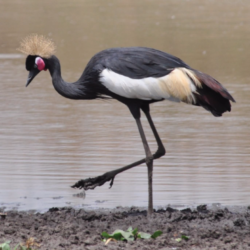
Ornithology
With a full 860 species recorded, including 18 found nowhere else in the world, Ethiopia is regarded by experts as one of Africa’s key birding destinations.
- Ethiopia’s prime attraction to visiting birders is the presence of 18 full national endemics. These include the spectacular Prince Ruspoli’s Turaco, peculiar Stresemann’s Bush Crow and melodious Abyssinian catbird.
. - The Nechisar nightjar is regarded to be the world’s rarest bird. The first (and thus far only) live specimen of this localised Ethiopian endemic was observed in 2009.
. - Ethiopia is the best place in the world to see several dozen regional endemics whose range only otherwise extends into Eritrea, Somalia or South Sudan. This list includes such typical highland birds as the handsome white-winged cliff-chat, brightly coloured black-winged lovebird, and marsh-loving Rouget’s rail.
. - Bale Mountains National Park was recently listed as one of the continent’s top five birding hotspots by the African Birding Club. Its checklist of 310 bird species includes six national endemics alongside another 11 species shared only with Eritrea, and the only known sub-Saharan breeding populations of golden eagle, ruddy shelduck and red-billed chough.
. - The highlands of northern Ethiopia are the best place in the world to see the mighty lammergeyer, which is regularly observed soaring above the Simien Mountains displaying its 2-metre wingspan.
. - The top months for birding tours are September to March, when resident species are boosted by a host of Palearctic migrants. However, since all those eagerly sought national and regional endemics are resident throughout the year, there is no bad time for birders to visit Ethiopia.
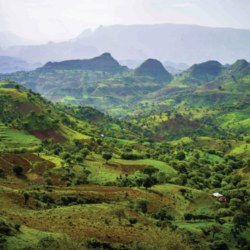
Dramatic Landscapes
From lush Afromontane forests and horizonless inland seas to the austere salt flats of the Danakil and windswept peaks of the Simien Mountains, Ethiopia is truly a land of breathtaking scenic variety and rich biodiversity.
- Ethiopia’s scenic centrepiece is a mountainous central plateau that covers half of its surface area, and supports the vast majority of its population. The most extensive contiguous block of fertile land in the eastern side of Africa, among them Ras Dashen in the Simiens, the fifth highest mountain in Africa.
. - The Ethiopian highlands support a remarkable diversity of habitats, each seemingly more scenic than the next. There are lush evergreen forests inhabited by monkeys and parrots, tall sculpted sandstone cliffs studded with ancient rock-hewn churches, high moorlands covered in green grass and pastel-shaded heather, and cultivated fields of tef, wheat and maize.
. - Bisecting the central highlands, the Great Rift Valley is the world’s most extensive tectonic chasm, hemmed in by sheer 1,000m-high escarpments and studded with a series of beautiful tropical lakes.
. - The northern Rift Valley, also known as the Danakil, is one of the world’s most volcanically collective regions. Dipping to 116 metres below sea level, and possessed of a thrillingly austere beauty, this unique region is swathed in active volcanoes, bubbling lava lakes, vast blinding salt flats and hostile soda lakes.
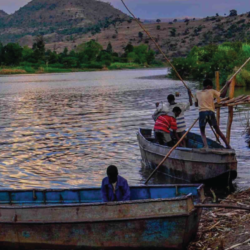
Lakes & Rivers
From the jewel-like string of crater lakes around Bishoftu to the oceanic expanses of Lake Tana, Ethiopia supports a wealth of freshwater habitats and associated birds and other wildlife.
- Ethiopia’s largest water body, Lake Tana extends across the northwestern highlands for 3,670 square kilometres and forms the centrepiece of a UNESCO biosphere reserve created in June 2015. Serviced by the bustling port town of Bahir Dar, Tana is one of Ethiopia’s most popular and engaging tourist destinations, thanks to its balmy tropical climate, fabulous birdlife, excellent amenities, and wealth of atmospheric mediaeval island monasteries.
. - Tana is the primary source of the Blue Nile, which starts its lengthy course to the Mediterranean close to Bahir Dar. Known locally as the Abay, the Blue Nile is widely identified with the Biblical river Ghion, which flowed out of the Garden of Eden to ‘encircle the entire land of Kush’ (an alternative Biblical name for Ethiopia).
. - The Rift Valley south of Addis Ababa supports a string of seven large and scenic freshwater and soda lakes. Of these, bilharzia-free Langano, its shore lined with upmarket resorts, is a popular weekend retreat from the capital, while Lake Ziway houses an island monastery established in 842 AD to provide temporary sanctuary to the Ark of the Covenant. All the Rift Valley lakes support a rich birdlife, with Abijatta in particular hosting one of Africa’s great ornithological spectacles, when hundreds of thousands of beautiful pink-hued flamingos collect to feed in its shallows.
. - Only 50km from Addis Ababa, Bishoftu – formerly Debre Zeyit – is set amidst a quartet of beautiful crater lakes whose steep volcanic rims are lined with resorts catering to all tastes and budgets. On the west side of Bishoftu, a non-volcanic lake called Chelekleka hosts thousands of migrant European cranes from November to February.
. - In the far west, the wide and sluggish Baro River, a tributary of the Nile, supports the sleepy tropical riverport of Gambella, which was once connected to Khartoum by regular cargo boats. Noted for the traditional cultures of its Anuwak and Nuer residents, Gambella is also the gateway to Gambella National Park, a remote wetland reserve that hosts Africa’s second-largest antelope migration, comprising around a million white-tailed kob, between March and June

Wildlife
The Afromontane forests and moorlands of Ethiopia protect some of Africa’s rarest and most alluring large mammal species, while lower lying savannah reserves are home to more typical safari wildlife such as lions and elephants.
- The world’s rarest wild dog, the endangered Ethiopian wolf is a handsome red-and-white carnivore that feeds mainly on rodents such as the giant mole-rat. Around half the global population of this Ethiopian endemic is centred on Bale Mountains National Park, while other strongholds include the Simien Mountains National Park and Guassa Community Conservation Area.
. - Bale Mountain National Park is also the main stronghold for the endemic mountain nyala, a large spiral-horned antelope associated with fragrant juniper-hagenia forest, and the sole preserve of the Bale monkey, whose tiny range is attributable to its specialised diet of bamboo.
. - Simien Mountain National Park is traversed by troops of several hundred gelada baboon, a striking Ethiopian endemic rendered unmistakable by the male’s flowing lion-like mane and heart-shaped red chest patch. Unique among living primates in that it feeds predominantly on grass, the cliff-roosting gelada is also often seen in other suitable habitats in northern Ethiopia, such as the Muger Gorge, Debre Libanos Monastery and Guassa Community Conservation Area.
. - The only goat indigenous to sub-Saharan Africa, the endangered Walia ibex, notable for the massive decurved horns sported by all adults, is associated with narrow cliff ledges in the Simien Mountains. It came perilously close to extinction in the 1960s, when the population dropped to below 200, but ban on hunting has seen numbers rise back to 1,200 in recent years.
. - Primates are well represented throughout Ethiopia, whether it be the black-and-white colobus that swing acrobatically through the forests of the western highlands, the mischievous vervet (grivet) monkeys that frequent riparian woodland along the Rift Valley lakes, or the Hamadryas and Anubis baboons characteristic of more open habitats such as Awash National Park.
As with many African countries, lion, elephant, buffalo, giraffe and other typical safari wildlife is now more-or-less restricted to a few protected areas, notably Chebera-Churchura, Mago, Omo and Gambella National Parks.
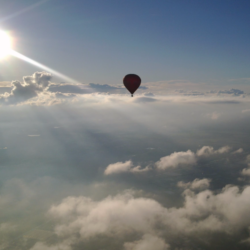
Balloon Safaris
With its craggy peaks bisected by the majestic Great Rift Valley, the magnificent mountain landscapes of the Ethiopian Highlands are best appreciated from on high.
- Ballooning is a relatively new activity in Ethiopia. The first documented balloon flight was pioneered by Abyssinia Ballooning, a Dutch-operated company, in 2012.
. - Abyssinia Ballooning has since operated more than 100 commercial balloon flights, mostly starting in Addis Ababa and exploring the surrounding countryside.
. - More recently, Abyssinia Ballooning has started offering flights in the Rift Valley lakes of Hawassa and Langano, as well as from Bahir Dar, close to where the Blue Nile exits Lake Tana.
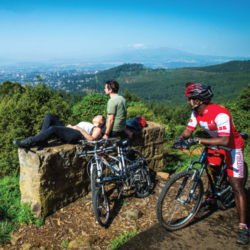
Bike Treks
An abundance of winding rural roads leading through lovely montane scenery make Ethiopia an ideal country to explore slowly by bike.
Set mostly at above 2,500 metres, the elevated countryside around Addis Ababa is also an ideal training ground for serious cyclists wanting to improve their altitude performance.
Cycling tours are a relatively new concept in Ethiopia, but several exciting routes are currently being operated.
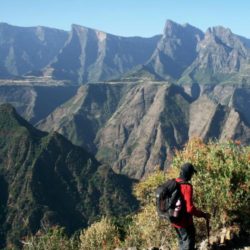
Hiking and Trekking
From bracing multi-day high-altitude treks through the Simien and Bale Mountains to moderately demanding day hikes amidst the remote rock-hewn churches of Gheralta and Lalibela, Ethiopia offers practically limitless opportunities for keen walkers.
- Described by the intrepid 1920s traveller Rosita Forbes as “the most marvellous of all Abyssinian landscapes”, Simien Mountains National Park, its “stupendous crags” and “gorges of clouded amethyst” rising to 4,533m at Ras Dejen (Africa’s fifth-highest mountain), remains the most popular trekking destination in Ethiopia.
. - Ancient footpaths, clambering over rocks worn smooth by centuries of continual use, lead adventurous visitors to the many remote rock-hewn churches that adorn the burnished sandstone cliffs of Gheralta.
Hiking is good throughout the year, but the scenery is at its best after the rains, from late September until December, when the countryside is swathed in various shades of deep green.

Running
Running is Ethiopia’s national sport, enjoying a profile comparable to that of football in Europe or baseball in the USA, and the country has produced many world-conquering marathon runners.
- Ethiopia earned its first Olympic gold medal in 1960, when Abebe Bikila, running barefoot, won the men’s marathon in Rome. He repeated the feat – this time wearing shoes – four years later in Tokyo.
. - Ethiopian long-distance runners have claimed another 19 Olympic gold medals since 1964. Champions include the three-time gold medalist Kenenisa Bekele and two-time 10,000m winner Haile Gebrselassie, who also held the world marathon record from 2007 to 2011.
. - The 10km Great Ethiopian Run, held in Addis Ababa every November since 2001, attracts around 40,000 local and international participants.
. - Established in 2014, the annual Ethiotrail is a trail running marathon set in scenic Abijatta-Shala National Park in the Great Rift Valley.
. - The 14km Wenchi Lake Trail Run, held every January, follows a high-altitude trail around the circumference of the crater lake on Mount Wenchi about 100km west if Addis Ababa.
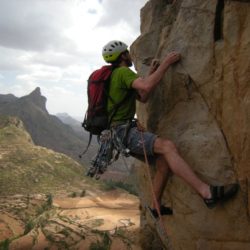
Rock Climbing
Although largely undeveloped as a climbing destination, Ethiopia boasts some of the most spectacular and challenging rockscapes in Africa, from the sandstone escarpment of Gheralta to the kilometre-deep cliffs that enclose the gorges of Simien Mountains National Park.
- Most tourists who visit the Gheralta region concentrate on the ancient rock-hewn churches that have been carved into its burnished sandstone cliffs. But these cliffs also offer some fantastically challenging rock climbing, as documented in the book Vertical Ethiopia, which describes a climbing expedition undertaken there by four women climbers in 2007
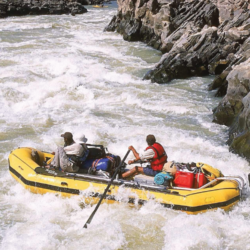
Water Rafting
Traversed by some of Africa’s mightiest rivers, including the Blue Nile, Ethiopia has enormous potential as a white-water rafting destination, though this is not currently exploited commercially.
- White-water rafting trips can be undertaken on the Blue Nile near Bahir Dar, lasting a few days, and on the Awash River, for one or two days.
. - Specialised expeditions have tackled other rivers, including the Tekaze, the Bashilo and the Baro.
. - Rafting can only be done at certain times of the year, after the rains, and needs to be set up well in advance. Currently no company in Ethiopia has the equipment or expertise to mount a rafting expedition, so all equipment would need to be brought in.
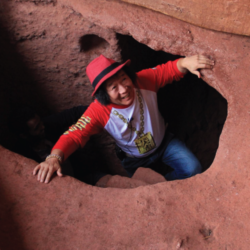
Caving
Some of Africa’s largest and most awe-inspiring cave systems run labyrinthine into the limestone slopes of eastern Ethiopia.
- Known to be at least 15km long, the Sof Omar Caves, carved by the Web River in the lowlands east of Bale, is Africa’s largest network of limestone caverns. No expertise or experience is required to explore a 1.7km walking trail that leads from the main entrance through a series of immense cathedral-like chambers studded with limestone pillars that stand up to 20m high.
. - Many of Ethiopia’s most characterful churches have been built into or excavated from caves. Accessible examples include the stunning Aksumite church of Yemrehanna Kristos and pretty monastery of Nakuta La’ab, both near Lalibela.


